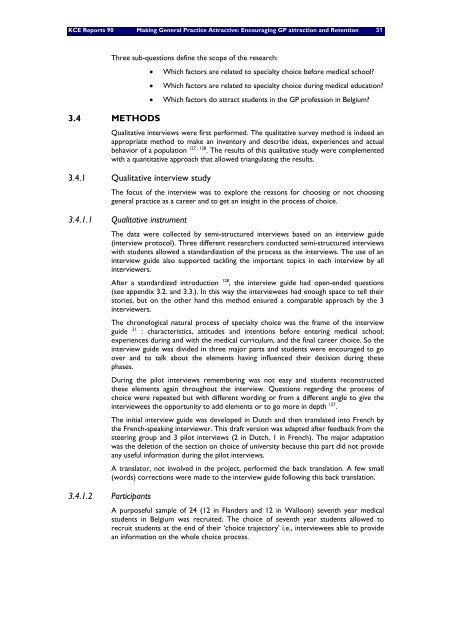Download the report (150 p.) - KCE
Download the report (150 p.) - KCE
Download the report (150 p.) - KCE
You also want an ePaper? Increase the reach of your titles
YUMPU automatically turns print PDFs into web optimized ePapers that Google loves.
<strong>KCE</strong> Reports 90 Making General Practice Attractive: Encouraging GP attraction and Retention 31<br />
Three sub-questions define <strong>the</strong> scope of <strong>the</strong> research:<br />
3.4 METHODS<br />
• Which factors are related to specialty choice before medical school?<br />
• Which factors are related to specialty choice during medical education?<br />
• Which factors do attract students in <strong>the</strong> GP profession in Belgium?<br />
Qualitative interviews were first performed. The qualitative survey method is indeed an<br />
appropriate method to make an inventory and describe ideas, experiences and actual<br />
behavior of a population 127 , 128 . The results of this qualitative study were complemented<br />
with a quantitative approach that allowed triangulating <strong>the</strong> results.<br />
3.4.1 Qualitative interview study<br />
The focus of <strong>the</strong> interview was to explore <strong>the</strong> reasons for choosing or not choosing<br />
general practice as a career and to get an insight in <strong>the</strong> process of choice.<br />
3.4.1.1 Qualitative instrument<br />
The data were collected by semi-structured interviews based on an interview guide<br />
(interview protocol). Three different researchers conducted semi-structured interviews<br />
with students allowed a standardization of <strong>the</strong> process as <strong>the</strong> interviews. The use of an<br />
interview guide also supported tackling <strong>the</strong> important topics in each interview by all<br />
interviewers.<br />
After a standardized introduction 128 , <strong>the</strong> interview guide had open-ended questions<br />
(see appendix 3.2. and 3.3.). In this way <strong>the</strong> interviewees had enough space to tell <strong>the</strong>ir<br />
stories, but on <strong>the</strong> o<strong>the</strong>r hand this method ensured a comparable approach by <strong>the</strong> 3<br />
interviewers.<br />
The chronological natural process of specialty choice was <strong>the</strong> frame of <strong>the</strong> interview<br />
guide 21 : characteristics, attitudes and intentions before entering medical school;<br />
experiences during and with <strong>the</strong> medical curriculum, and <strong>the</strong> final career choice. So <strong>the</strong><br />
interview guide was divided in three major parts and students were encouraged to go<br />
over and to talk about <strong>the</strong> elements having influenced <strong>the</strong>ir decision during <strong>the</strong>se<br />
phases.<br />
During <strong>the</strong> pilot interviews remembering was not easy and students reconstructed<br />
<strong>the</strong>se elements again throughout <strong>the</strong> interview. Questions regarding <strong>the</strong> process of<br />
choice were repeated but with different wording or from a different angle to give <strong>the</strong><br />
interviewees <strong>the</strong> opportunity to add elements or to go more in depth 127 .<br />
The initial interview guide was developed in Dutch and <strong>the</strong>n translated into French by<br />
<strong>the</strong> French-speaking interviewer. This draft version was adapted after feedback from <strong>the</strong><br />
steering group and 3 pilot interviews (2 in Dutch, 1 in French). The major adaptation<br />
was <strong>the</strong> deletion of <strong>the</strong> section on choice of university because this part did not provide<br />
any useful information during <strong>the</strong> pilot interviews.<br />
A translator, not involved in <strong>the</strong> project, performed <strong>the</strong> back translation. A few small<br />
(words) corrections were made to <strong>the</strong> interview guide following this back translation.<br />
3.4.1.2 Participants<br />
A purposeful sample of 24 (12 in Flanders and 12 in Walloon) seventh year medical<br />
students in Belgium was recruited. The choice of seventh year students allowed to<br />
recruit students at <strong>the</strong> end of <strong>the</strong>ir ‘choice trajectory’ i.e., interviewees able to provide<br />
an information on <strong>the</strong> whole choice process.
















